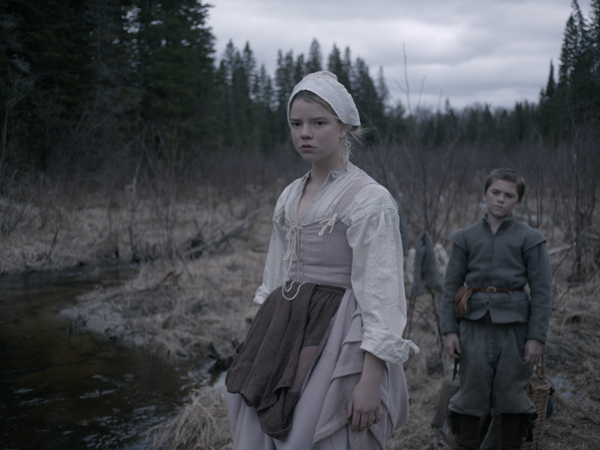
– By Cate Marquis –
Atmospheric, historic “The Witch” is more creepy than scary
“The Witch” is an ambitious film that seeks to re-imagine of the horror movie genre by going back to the terror of the Salem witch trials and the 17th century witch-hunt hysteria that led to them. Set in 1630s New England, a family of Puritan colonists leave their religious settlement to carve out their own farm in a remote area at the edge of a dark forest, where disturbing things begin to happen.
First-time writer/director Robert Eggers debuted “The Witch,” at the 2015 Sundance Film Festival, where he won the Best Director Prize in the U.S. Narrative Competition. The barren, late fall locations, desaturated shadow-filled photography and careful period details create the perfect eerie atmosphere. Yet despite its ambitions, a good cast and convincingly authentic historical setting, “The Witch” is more creepy than truly scary.
Deeply religious William (Ralph Ineson) and his wife Katherine left their native England to find a new life and religious freedom in the New World. However, an issue that is never described has put them in conflict with their church and the family of five leave their colonial plantation, as these settlements were called, ahead of a threat of banishment. William selects a piece of land near a small stream and on the edge of a looming, dense forest.
The film creates a sense of eerie foreboding from the start, where the family’s isolation in the remote location creates a palpable fear barely contained by the patriarch’s loudly proclaimed faith in God’s protection. The fear is most clearly seen on the face of oldest daughter Thomasin (Anya Taylor-Joy). Life is hard and a lot of responsibility falls on the teen-aged girl, particularly for the care of her younger siblings, pre-teen Caleb (Harvey Scrimshaw), mischievous younger twins Jonas and Mercy (Lucas Dawson and Ellie Grainger) and baby Samuel. When Samuel mysteriously disappears, whispers of witchcraft surface.
Eggers clearly has did a lot of research and took care to create a historically accurate picture of colonial life. Much of the dialog was drawn from period writings and records of superstitions about witches, such as blaming witches if a cow stopped giving milk, form the basis for some events in the film. The strong cast includes a couple of British actors from “Games of Thrones,” Ineson and Dickie, whose performances anchor the story. Character actor Ineson’s strong Yorkshire accent served as an inspiration as the director, a New Hampshire native, created his script, and the actor coached the younger actors in the regional accent. Newcomer Anya Taylor-Joy is well-cast as Thomasin, portraying both a child-like innocence and a luminescent blonde beauty, perfect for her role as a girl with one foot in childhood and one in womanhood. Thomasin wavers between striving to please her parents and resenting the heavy load that falls to her as both the oldest and a girl in a strict, patriarchal society.
Unfortunately, Eggers’ commitment to authenticity backfires, with the actors’ thick Northern English accents and old-fashioned speech making some dialog difficult to follow, at least for American audiences. Although the point of scenes are generally clear anyway, it gives to an extra challenge. More problematic is that too often the film falls back on familiar horror film tricks. and it wavers back and forth on whether supernatural forces are really at play or whether is it the play of imagination. In some scenes, viewers can feel as if they are watching an excerpt from “The Crucible,” where adults in the grips of religious paranoia lose perspective to give credence to the claims of imaginative, mischievous children. In other scenes, witches of Grimm’s’ fairy-tales lurk in the dark forest, carrying out gruesome ceremonies, so audiences are left wondering whether witches are myth or fact in the film’s world. The director’s intent was likely to be ambiguous but the effect just comes across as muddy and confused.
Like the real Salem witch trials, repressed sexuality plays a role in the imaginings, and people are not above exploiting the paranoia about the supernatural or satanic to cover up their own failings. That all this is taking place with a small family is both chilling and horrifying. On the other hand, the character make the same mistakes people always do in horror films – they talk about leaving but then don’t, if these is something creepy about the basement (in this case, the creepy woods and then the barn), they invariably go there anyway, preferable after dark and alone.
With its strong cast and careful historic setting, one wishes “The Witch” was a scarier film. As it is, “The Witch” wavers between creepy and dully predictable.
© Cate Marquis